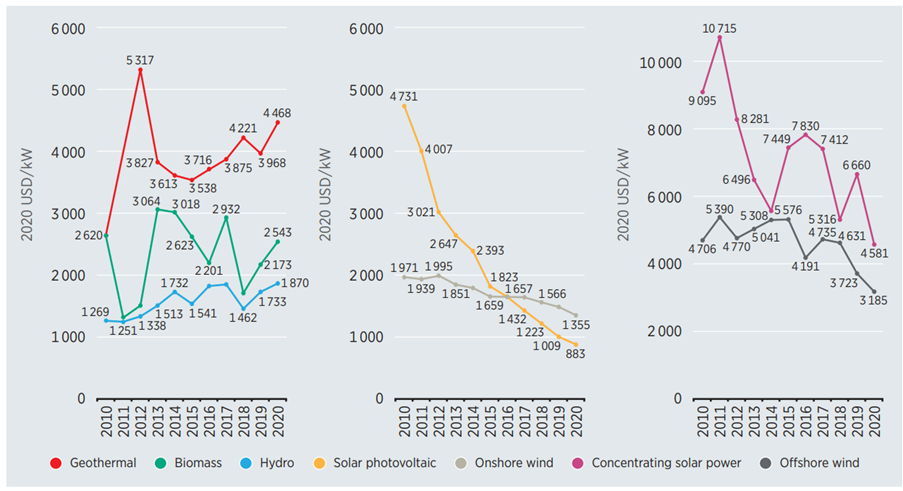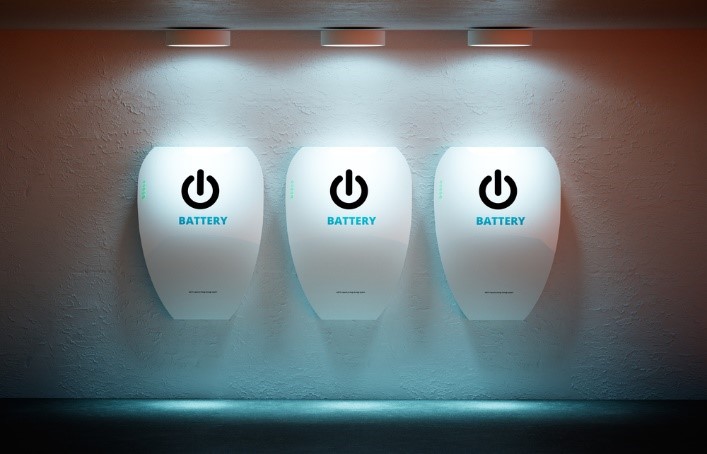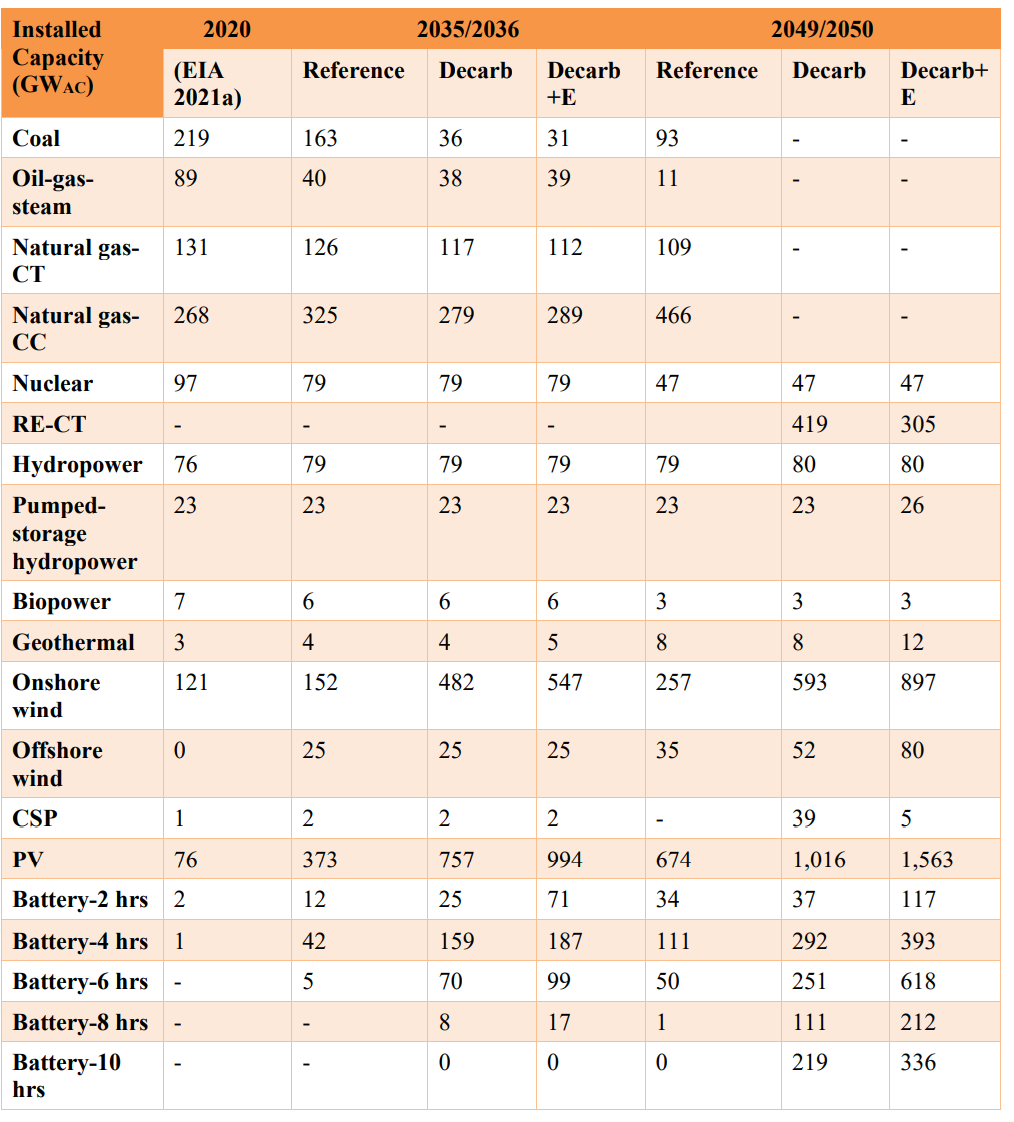

Back to all
September 17, 2021
Gabriela Herculano
Credit: Photo by Lee Jonas from Pexels
When Will the Grid be Green And How Much Storage Will That Require?
By Gabriela Herculano, September 2021
There is much debate on whether the US energy system (or that of any country) should be 100% renewable energy based. As we know, the problem is intermittency, as the sun does not shine and the wind does not blow all the time. Those who believe that a purely green grid is achievable differ on the degree to which energy storage needs to advance and reduce in price before that vision is realised, while some researchers argue that renewables will ultimately fall short and the grid of the future will require nuclear, natural gas or biomass power plants (that could run with carbon capture and storage, even if such technology is very expensive).
In this article we summarise two of the leading views on this path towards a green grid in the US. On one side lie the bold predictions of thought leader and educator Tony Seba, published in October 2020, that the US grid could become 100% renewable and clean storage based by 2030. On the other hand, lie the conclusions of the US Department of Energy’s recently published Solar Future Studies, produced by the office of Energy Efficiency and Renewable Energy. Before we cut to the chase and outline these different potential paths towards a predominantly renewable grid, let’s go over a few key points.
1. The Tipping Point towards a Renewable Grid is Solar’s Increasing Price Competitiveness
The previous decade was transformative for solar and batteries. Not only is solar now the cheapest source of electricity, but most analysts expect solar panel prices to continue to go down. Therefore, it makes economic sense to replace outdated infrastructure with a source of energy that is only increasing in competitiveness.
The average utility scale solar farm in the US is about 5 MW in size. To build such a solar project would have cost US$23.6 million in 2010. This plummeted to US$4.4 million by 2020 and could cost as little as $1.1 million in 2030 (that is ca. 95% capex reduction in 20 years).
The International Renewable Energy Agency (IRENA) summarizes in the graph below the evolution of total installed cost by different technologies. Comparing the seven types of renewable energy, it is noticeable that solar (PV and Concentrated Solar Power (CSP)) and wind (onshore and offshore) are the ones experiencing a downward price trajectory. Between 2010 and 2020 the global weighted-average total installed costs of utility-scale solar PV went down by 81% (from US$ 4,731/kW in 2010, to ca. US$ 883/kW in 2020). As most US utility scale solar PV is 5 MW or less in size, it means that the average solar farm had a cost of ca. US$23.6 million to build in 2010 but ca. US$4.4 million in 2020. Also striking is that at the beginning of the decade, solar PV was 2.4x more costly than onshore wind. Parity was achieved in 2016 and by the end of 2020 wind was 1.5 x more expensive than solar.
Global weighted-average total installed costs by technology, from 2010 to 2020

Tony Seba and his team at RethinkX forecast that the combined capital cost of solar PV, wind power, and batteries will decline a further 75% by 2030 . This means that the total installed costs of utility-scale solar PV could reach US$ 221/kW by 2030, so that average 5 MW solar PV farm would cost ca. US$ 1.1 million to be built less than 10 years from now. As a reference, the Energy Information Administration, EIA, estimates that the base cost for a natural gas fired combined cycle power plant in 2020 totals US$958/kW. On top of the upfront capex, to run such a plant of course requires continuous variable costs purchasing the fuel that needs to be burned.
2. Solving Intermittence is a Requirement
In electricity markets supply must equal demand at any given time or there will be a blackout. Renewable energy is, however, not dispatchable, meaning it cannot be turned on or up in reaction to the grid’s requirements. A grid with a lot of renewable sources will therefore require many ways to manage the fluctuations of wind and solar. Therefore, being able to store green electrons for times of peak demand when the sun is not shining (or the wind is not blowing) is necessary. The solution, seen as the holy grail for renewable based grids, is battery based clean energy storage.

According to the Solar Futures Study, the US had in 2020 around 76 GW of solar capacity (of which 46 GW was utility scale, 28 GW was distributed solar and 2 GW was CSP), which supplied ca. 3% of the country’s electricity demand.
While renewable energy is not dispatchable, clean energy stored in batteries is. In 2019 NREL published a study on the potential for batteries to provide peaking capacity in the short term (current conditions being ca 1,187 GW of U.S. generation capacity and ca 261 GW of fossil-fuel based peaking capacity). NREL demonstrated the ability for utility-scale battery storage to fulfil a material part of the peak capacity needs in the US. With current conditions, they concluded that 28 GW of potential for 4-hour storage was necessary to provide peaking capacity. A virtuous cycle may develop: “This deployment could help decrease storage costs—and storage deployed primarily to provide peaking capacity can provide additional benefits, such as a sink for low- or zero-value PV generation during non-peak periods. This in turn can enable greater PV deployment, which then increases the potential of 4-hour storage. This effect can extend the practical potential for 4-hour storage to 50 GW or beyond nationally. The general effect should provide additional potential for cost reductions to increase the competitiveness of 6 or 8-hour storage”.

Battery Storage System Key Terms
Energy capacity: Maximum amount of stored energy (in kWh or MWh)
Storage duration: The amount of time storage can discharge at its power capacity before depleting its energy capacity (e.g., a battery with 1 MW of power capacity & 4 MWh of usable energy capacity will have a storage duration of four hours)
Source: Grid-Scale Battery Storage FAQ
The positive development of in front of the meter, utility-scale battery storage could converge with battery technology advancements as electric vehicles become mainstream. Clean energy storage can come in anumber of forms. Firstly, traditional utility scale in front of the meter storage, a form that could see significant growth as the mainstreaming of electric vehicles drives advancements in battery technology. Clean energy storage can also be behind the meter (at the point of consumption). It can also be mobile (like aggregating the batteries inside millions of EVs, in what is called vehicle to grid, V2G) or stationary (for example the management of distributed behind the meter residential batteries as a virtual power plant, VPP). For a grid to become purely renewable based we need to have this clean energy storage in place. The need for future clean energy storage is likely to be met by a combination of utility scale in front of the meter, as well as behind the meter V2G, and VPPs.
3. Battery Energy Storage Systems Are Already in Place
How much storage will be needed as the grid transitions to being predominantly renewable based is a question that needs to take into account discharge durations. By the end of 2020 the installed capacity of the US system had 3 GW of battery storage, with a maximum discharge duration of 4 hours. As we will soon see, the US Department of Energy forecasts a material increase in battery storage system size - potentially as much as ca. 124x more than current battery capacity by 2035, but only later (in a third phase) duration would increase from current levels.
Although battery as a service is to grow exponentially, the battery storage systems in operation are a precedent and a reference in terms of how the economics of the use of such assets work. Broadly speaking, battery storage systems can generate revenue by arbitrage, that is by charging the batteries with electricity when prices are low and discharging when prices are high, that way load levelling the system. This helps to reduce the amount of renewable energy that gets curtailed. Similarly, battery systems (that are dispatchable, as mentioned above) can be used for peak capacity, displacing higher cost generators; usually fossil fuel-based plants. Lastly, additional operating reserves and ancillary services such as frequency regulation can help to ensure grid reliability. Most of the services provided by the current battery storage in the US are related to operating reserves & ancillary services. The table below summarizes all the applications of utility scale energy storage.
Applications of Utility Scale Energy Storage

100% SWB By 2030
In October 2020, Tony Seba and team at RethinkX published a report where they stated that “it is both physically possible and economically affordable to meet 100% of electricity demand with the combination of solar, wind and batteries (SWB) by 2030 across the entire continental United States as well as the overwhelming majority of other populated regions of the world. ”The primary driver of this move to a fully SWB system would be its economic benefits, as Seba asserts that solar is to become overwhelmingly the cheapest possible type of electricity source. The lowest cost SWB architecture would therefore be one with 10x more solar than wind. The implications of such a system would be profound, as the marginal cost of energy would be near zero for most parts of the year. It is not a matter of if renewables will be predominant, but a matter of when.
“Falling costs drive technology disruptions. Solar and wind are already the cheapest new generation options, and cost less than existing coal, gas, and nuclear power plants in many areas. The cost of SWB systems will fall another 70% by 2030, making disruption inevitable.” Tony Seba
Seba estimates that the electricity produced by a 100% SWB system in 2030 would be US$30/MWh. He also believes that, contrary to what most researchers say, a 100% SWB does not require vast amounts of battery storage. His model is based on the idea that the electricity system must be designed to maximize energy surplus production (rather than erroneously trying to minimize curtailed energy). As SWB capacity grows in the system, these technologies will produce a growing volume of surplus energy at near-zero marginal cost. Seba calls this “Clean Energy Super Power”. This is because the system’s capacities must be built in order to completely meet electricity demand even in shorter winter cloudy days. As a consequence, 100% SWB would be able to produce much more power throughout the rest of the year, meaning storage would be less crucial.
The investment to construct this 100% SWB system in the continental US by 2030 would be less than $2 trillion in total (Seba’s team estimate this to be just 1% of the country’s GDP). RethinkX’s simulation optimized the balance between solar and wind generation cost and the cost of batteries and found that the least expensive 100% SWB system would have 3x to5x more total generating capacity than today’s grid but would require only 35 to 90 hours’ worth of batteries. This calculation depends on location. In case of California, the team simulated a limit scenario where the system in 2030 would have ca 1,200 GWh of battery energy storage capacity installed, which could allow for a sustained discharge power output of 2,400 GW.
78% SWB By 2035 (90% By 2050)
The Solar Futures Study by the US Department of Energy is an impressive modelling of many complex and mutually inclusive trends (costs of different technologies, electrification of transportation and heat and impact on demand, several technologies unfolding, and speed of costs decline). Three scenarios are presented:
- Moderate Case: Renewable energy and storage technologies benefit from moderate cost reductions, a base case electricity demand, and the current policies on emissions limits including clean energy mandates and federal tax incentives.
- Decarbonization Case: Advanced cost reductions for renewable energy technologies, base case electricity demand, and policies in line with a CO2 emission reduction (vis-à-vis 2005 levels) of 95% by 2035 and 100% by 2050.
- Decarbonization With Electrification Case: Advanced cost reductions for renewable energy technologies, a high electrification case, and policies in line with a CO2 emission reduction (vis-à-vis 2005 levels) of 95% by 2035 and 100% by 2050.
Too little storage could cause blackouts, but too much storage would be too costly. The model, in all three scenarios, takes this optimization conundrum into account and anticipates three distinct phases interms of clean energy storage. At first, running through the late 2020s, limited growth in storage takes place. At 5 GW per year, this is mostly intraday storage. The second phase, from the late 2020s to the late 2040s, sees accelerated storage deployment (due to declining battery costs and the retirement of fossil fuel firm plants), still mostly intraday (but jumping from 2 to 4 hours to 6 to 8 hours). During a third phase, beginning in the late 2040s, long duration storage will represent most of the new storage additions.
As battery storage is to grow in duration only post the 2040s, in the near term the assumption is that curtailing solar electricity is a cost-effective way to integrate solar. Total curtailed PV and wind generation is expected to be between 7% and 8% by 2035, growing to between 9% and 13% by 2050. The study also considers transmission expansions that could take energy from solar abundant areas to demand centres. Load flexibility and demand management are also considered, like building loads being shifted to optimize solar use and EVs chargers controlled to maximize daytime charging.
The study highlights that one third of solar capacity to date belongs to consumers on distributed networks. The study also notes the rise of other distributed energy resources (DER) such as electric vehicles, batteries and flexible loads. The study estimates that roughly 80% to 90% of all new renewable capacity will be utility scale solar, with 10% to 20% being smaller scale distributed solar.
Historical & Modelled Capacities for the US Electricity System

So, we finally get the answer. Battery storage is to jump from the current 3 GW to between 59 GW and 374 GW by 2035. It is interesting to note that the ratio of solar PV in the system between the Decarbonisation + Electrification and the Reference cases is ca. 3x (994 GW versus 373 GW) by 2035, while in the same year the ratio of battery storage capacity between the two cases is ca. 6x (374 GW in total versus 59 GW). The more solar the system has, the more it needs storage.
A similar observation applies to the total battery storage by 2050. In the Reference case 196 GW of storage would be needed, versus 1,676GW in the Decarbonization + Electrification case.
Historical & Modelled Generation Shares for the US Electricity System

In terms of annual generation, the Study indicates that SWB would jump from the current 12% to potentially 78% by 2035 and ca. 90% in 2050 in the Decarbonization + Electrification case. It is worth highlighting that in this most aggressive case, in 2035 ca. 5% of electricity would still be produced by fossil fuel sources, but that would finally get to zero by 2050.
Not If, But When
A predominantly renewable based grid requires storage. In the short term, leveraging all existing batteries will be very relevant. That is why V2G and VPPs are poised to proliferate in the next ten years. It makes economic sense to use the mobile storage inside electric vehicles and all stationary storage behind the meter and several companies have developed thetechnology that allows the use of these storage assets. Achieving long term duration will require solutions beyond lithium ion - enter green hydrogen as a solution to solve seasonal storage. The technologies exist, investments are flowing, solutions are scaling up. The scenarios modelled by RethinkX and the Solar Futures Study (summarized below) are both within reach.

As RethinkX said, “It is no longer a matter of if the SWBdisruption of energy will happen, it is only a matter of when and where”.The rate of decline in the cost of solar panels and batteries will be the twomain drivers of the speed of change. The decision to embrace SWB is absolutelynot political, it is a rational economic one. We are lucky that an additionalpositive externality is that it decarbonizes the planet.